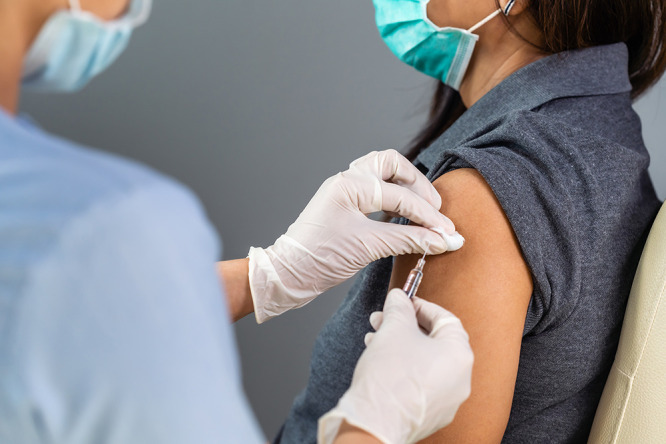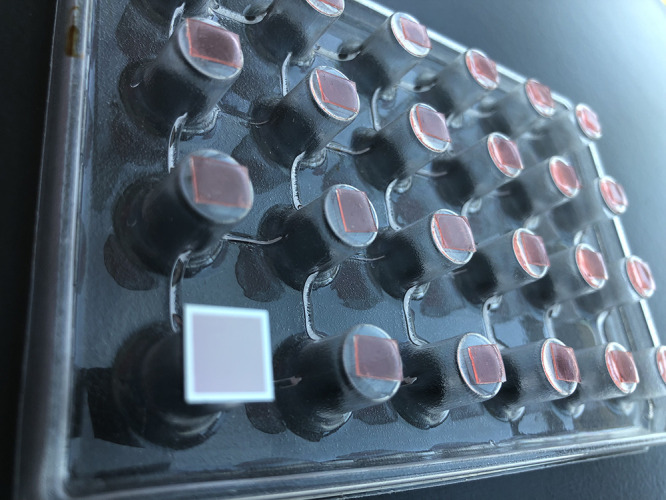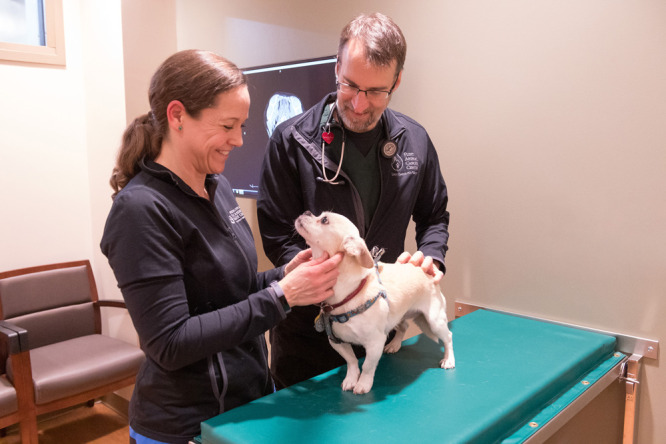What if someone told you that a vaccine shot could prevent you from getting multiple types of cancer—ones as different from each other as breast cancer and lymphoma?
Stephen A. Johnston, cofounder of the healthcare startup Calviri and a scientist at Arizona State University’s Biodesign Institute, has a lot of experience telling people that such a vaccine is possible. However, the response he usually gets—especially from immunologists and cancer biologists—is a sardonic chuckle, if not a blatant eye roll. But Johnston is betting that he’ll get the last laugh. He is currently testing a preventive cancer vaccine, which induces an immune response to peptides produced from mutated mRNA, in a $6 million, five-year study in dogs. The study, called the Vaccination Against Canine Cancer Study, or VACCS, is the largest, most expensive interventional veterinary cancer trial to date.
Although testing cancer therapies in dogs is still unusual in cancer research, the practice is growing, as scientists realize that our canine friends provide a much better preclinical model than mice. “If we show that [the vaccine] is successful in dogs, it’s really hard to argue why you wouldn’t try to do this in people,” Johnston says.
A preventive cancer vaccine—especially one targeting several cancer types—would undoubtedly be a win in the battle against cancer. Immunotherapies over the past decade have demonstrated the potential in recruiting the immune system to treat cancer, but cancer vaccine development is still in its early days. Scientists in academia and industry are investigating a slew of approaches for targetingtumors with a vaccine, though only a few have reached clinical trials so far. The coronavirus pandemic has boosted the field, because many efforts to develop cancer vaccines rely on delivery of mRNA, a process brought to commercial fruition through developing mRNA-based vaccines against COVID-19.
Indeed, the German drug company BioNTech, one of the groups that developed that mRNA delivery technology, had originally conceived of the technology to deliver vaccines to target tumors. BioNTech and several other companies are currently conducting clinical trials on a type of cancer vaccine that relies on peptides called neoantigens. Researchers have known for decades that mutations in tumor-cell DNA can produce neoantigens when that DNA gets transcribed and translated, and some of these peptides can stimulate an immune response. By delivering them in a concentrated form, vaccine developers hope to spur the immune system to attack the tumor.
But such vaccines are designed to treat cancer, not prevent it, and most need to be personalized to the set of neoantigens made in a given patient’s tumor, so even if the vaccines work, they are likely to be costly. That is not what Johnston wants for prevention. “We have always envisioned that whatever we develop would be inexpensive enough to be available to the whole world,” he says, which means something that can be used off the shelf.
Inventing a Vaccine
Johnston is the first to admit that he’s no immunologist, instead referring to himself as an inventor whose work spans biomedical applications. For example, in 1989, he copatented a technology called particle-mediated gene delivery, also referred to as a gene gun, that is now widely used in biology. When he and his colleagues first began to explore the idea of a preventive cancer vaccine almost 2 decades ago, they did not have an approach in mind. “It was just an inventor saying, ‘Wouldn’t it be nice if nobody got cancer?’” he says. “Of course, people said it was not a feasible idea, but we suspected they had missed some stuff and that their logic wasn’t tight.”
Not long after, in 2003, Johnston and a postdoc in his lab who was an oncologist had chanced upon neoantigens in tumors that were produced by mutations—not in DNA but in mRNA. Johnston was intrigued and though the lab did not publish the findings at the time, he filed a patent on the discovery in 2006. Normal cells have quality-control mechanisms to ensure that mRNA is correctly transcribed from gene-coding regions in DNA, but tumor cells make frequent transcription mistakes, including adding in or cutting out nucleotides to produce mRNA riddled with errors called frameshift mutations. Researchers think the peptides produced from such error-heavy genetic material generate a stronger immune response than from mRNA or DNA in which a single nucleotide is mutated, says Omar Abdel-Wahab, an oncologist at Memorial Sloan Kettering Cancer Center who is not involved in the VACCS trial.
Johnston’s team found that the junk protein translated from mRNA frameshift mutations was indeed highly immunogenic. Mice, dogs, and people with tumors generate antibodies to the peptides, but there are not enough of those antibodies to kill the cancer. They also found that subsets of peptides produced by different people overlapped—across both individuals and cancer types. By priming the immune system with a mighty dose of these antigens before cancer develops, Johnston surmised, it may be possible to stomp out tumors immediately as they appear—similar to how preventive vaccines fight infectious diseases.
Obtaining the tumor tissue and sequencing the mRNA to identify the mutations proved extremely labor-intensive, so they created a chip that could capture the antibodies and synthesize the peptides against which they were generated. “That was really the technological challenge—developing the surface chemistry and synthesis system to synthesize 400,000 peptides on one chip,” he says. With that tool, they could take a drop of blood from a mouse, a dog, or a person; identify the peptides made by several types of tumors; and pick out the frequently occurring ones to create a single vaccine.
The skepticism that immunologists and oncologists have about the approach stems from a couple of things. For one, the idea of a preventive vaccine—apart from ones against cancers caused by viruses such as human papillomavirus—raises experts’ eyebrows. For another, the idea that a single injection can target multiple cancer types strikes many as unrealistic. What’s more, the mechanism Johnston is targeting has almost no precedent in the literature. “There’s certainly some really creative and innovative aspects to this,” says Peter P. Lee, an immuno-oncologist at City of Hope Comprehensive Cancer Center. There’s no problem with the idea that mutations at the mRNA level may result in antigens that trigger the immune system, Lee says. “But can one basically a priori predict the universe of these such events to make a preventive vaccine that can cover most if not all potential tumor types? That, I think, is pretty pie in the sky.” Different people are likely to have enormously variable and unpredictable responses to all the different antigens. “It’s just that the complexity is very high,” he says.
Johnston says he’s heard many objections to the work over the years, but he believes the data are strong enough to at least put the vaccine to the test. Meanwhile, emerging work may provide more plausibility for his vaccine. For example, Abdel-Wahab and his colleagues used drugs to induce frameshift mutations in mRNA and reported that the resulting neoantigens spur the immune system strongly enough to be explored in cancer therapy. And multiple teams, including researchers led by Keith L. Knutson, an immuno-oncologist at the Mayo Clinic, are now working on preventive cancer vaccines, though not ones based on neoantigens.
For their part, Johnston and his colleagues have so far published just a few papers on the approach, showing that the frameshift peptides drive the immune system to produceantibodies in mice, dogs, and people. The current iteration of the vaccine uses peptides from eight different cancer types, but his team’s studies are showing that peptides produced early in the disease differ from those produced later. “That is why we are designing a new vaccine based only on samples from early disease and many more cancers,” he says. Their most recent paper reported that, in mice, the shared neoantigen approach dampened tumors as effectively as the kinds of personalized neoantigens currently in clinical trials.
Of Mice and Dogs
Curing cancer in a mouse, however, is not especially impressive. “The fact that something works in a mouse means nothing about whether it’s going to work in people,” says Douglas Thamm, a veterinary oncologist at Colorado State University who is leading the dog vaccine trial. Yet two major hurdles—time and money—stymied human testing of Johnston’s vaccine. The incidence of cancer in the United States is ∼442 per 100 000 adults, so to get statistically significant results, researchers would have to inoculate tens of thousands of healthy people, then follow them for years to see whether a smaller percentage of those who got the shot develop cancer—a hugely expensive prospect.
That is where dogs come in. Over the past decade, cancer researchers have begun to realize that our canine companions offer an excellent proving ground for testing new therapies. Dogs develop cancer spontaneously, at similar rates as people over their lifetimes, whereas tumors in mice generally must be artificially induced. Dogs also have immune systems broadly similar to ours, and they share our environment, explains Amy K. LeBlanc, director of the comparative oncology program at the National Cancer Institute, who is not involved in VACCS. “If you have a dog, it probably slept in your bed with you last night. It eats scraps from your table and goes on walks with you through your neighborhood,” she says. “So the immune repertoire [dogs] have is likely more akin to what we have.” Yet because their expected life spans are so much shorter—8–14 years compared with humans’ 73 years—clinical trials can be run in significantly less time.
Thamm has spent years conducting canine oncology studies designed not just to help dogs but also to inform the development of therapies for human cancer. So when Johnston suggested testing his vaccine in dogs, Thamm’s ears perked up. The duo had already been collaborating on a diagnostic version of the peptide-detecting chip. (Johnston’s company, Calviri, is developing the diagnostic, and he expects it to reach the market within five years.) When Johnston first mentioned his vaccine idea, Thamm responded with the usual skepticism, but he gradually came around. “Initially you kind of guffaw, but then he keeps piling on more and more data, and then you go, ‘Alright, maybe this isn’t that ridiculous,’” Thamm says. After a long search for funding, they received the green light for the dog trial from Open Philanthropy, an organization whose mission is to fund risky but big-impact projects that more traditional funders overlook.
The trial, which is taking place at three academic veterinary centers across the United States, is enrolling healthy, middle-aged, cancer-free dogs of various mixed and pure breeds. So far, the study has signed up almost 700 of its 800 participants. Dogs get a series of four shots over the first two months and then annual boosters for the five years of the trial. Their owners must also bring them in twice a year for researchers to test for cancer as well as to monitor immune system function and other biological and health parameters. Then, researchers will compare the incidence of cancer in dogs that received the vaccine with dogs that received an adjuvant plus peptides (or DNA encoding them) not produced by mRNA frameshift mutations. Because of the intense monitoring, Thamm says, he hopes any cancers detected will be found early, giving the animals a better chance of survival. And the study has set aside funds to defray some costs of treating dogs that do develop cancer, whether they are in the vaccine or placebo group. “As a veterinarian, I find that very gratifying,” Thamm says.
Even skeptics like City of Hope’s Lee agree that, if the vaccine works in dogs, it is likely to work in people. “Having an open mind, I’m open to seeing the data from the trial,” he says. But his expectations for the trial are tempered at best. In addition to how complicated it is to predict the immune system’s response to so many peptides at once, Lee also questions whether the studies on how well the vaccine works in mice support the idea that it prevents cancer, rather than just delays it. Thamm counters that even a delay could provide a significant clinical benefit. Additional cancer-free months observed in vaccinated mice could extrapolate to years in dogs and humans, he says. Lee contends that such a translation is unlikely. “Things generally work less well when you bring them to humans,” he says.
But whether or not the vaccine succeeds, notes the NCI’s LeBlanc, what researchers learn—even from the trial’s control arm—will be a massive boon for understanding the immunology of canine cancer and, by extension, human cancer. Simply getting a baseline of the immunological changes in canine cancers over time will empower a more effective translation between the two species, she says. “It represents a really opportune way to showcase what we can learn about cancer from dogs.”
Alla Katsnelson is a freelance contributor toChemical & Engineering News, an independent news publication of the American Chemical Society.

Could a vaccine prevent cancer? A canine clinical trial of a neoantigen-based vaccine could open the door for future testing in people. Credit: BaLL LunLa/Shutterstock.

Stephen Johnston and his colleagues developed a 0.5 cm2 chip carrying 400,000 frameshift peptides. The chip screens blood from dogs with cancer to identify antibodies against those peptides that could be effective in a preventive cancer vaccine. Credit: Stephen Johnston.

Danielle Biggs (left) and Douglas Thamm (right) of Colorado State University’s Flint Animal Cancer Center examine a canine patient enrolled in the Vaccination Against Canine Cancer Study. Credit: William A. Cotton/Colorado State University Photography.
In collaboration with C&EN.


